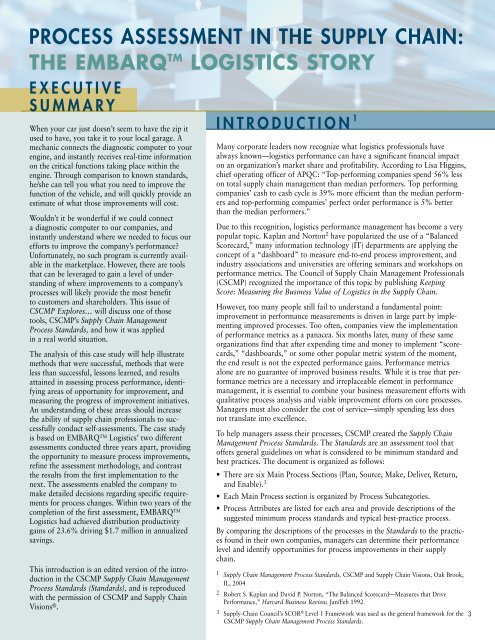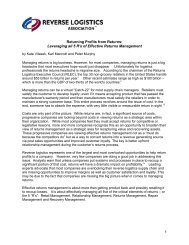PROCESS ASSESSMENT IN THE SUPPLY CHAIN: the eMBARQtM ...
PROCESS ASSESSMENT IN THE SUPPLY CHAIN: the eMBARQtM ...
PROCESS ASSESSMENT IN THE SUPPLY CHAIN: the eMBARQtM ...
You also want an ePaper? Increase the reach of your titles
YUMPU automatically turns print PDFs into web optimized ePapers that Google loves.
Process Assessment in <strong>the</strong> suPPly chAin:<br />
<strong>the</strong> eMBARQ tM Logistics stoRy<br />
e x e c u t i v e<br />
s u m m A r y<br />
When your car just doesn’t seem to have <strong>the</strong> zip it<br />
used to have, you take it to your local garage. A<br />
mechanic connects <strong>the</strong> diagnostic computer to your<br />
engine, and instantly receives real-time information<br />
on <strong>the</strong> critical functions taking place within <strong>the</strong><br />
engine. Through comparison to known standards,<br />
he/she can tell you what you need to improve <strong>the</strong><br />
function of <strong>the</strong> vehicle, and will quickly provide an<br />
estimate of what those improvements will cost.<br />
Wouldn’t it be wonderful if we could connect<br />
a diagnostic computer to our companies, and<br />
instantly understand where we needed to focus our<br />
efforts to improve <strong>the</strong> company’s performance?<br />
Unfortunately, no such program is currently available<br />
in <strong>the</strong> marketplace. However, <strong>the</strong>re are tools<br />
that can be leveraged to gain a level of understanding<br />
of where improvements to a company’s<br />
processes will likely provide <strong>the</strong> most benefit<br />
to customers and shareholders. This issue of<br />
CSCMP Explores… will discuss one of those<br />
tools, CSCMP’s Supply Chain Management<br />
Process Standards, and how it was applied<br />
in a real world situation.<br />
The analysis of this case study will help illustrate<br />
methods that were successful, methods that were<br />
less than successful, lessons learned, and results<br />
attained in assessing process performance, identifying<br />
areas of opportunity for improvement, and<br />
measuring <strong>the</strong> progress of improvement initiatives.<br />
An understanding of <strong>the</strong>se areas should increase<br />
<strong>the</strong> ability of supply chain professionals to successfully<br />
conduct self-assessments. The case study<br />
is based on EMBARQ TM Logistics’ two different<br />
assessments conducted three years apart, providing<br />
<strong>the</strong> opportunity to measure process improvements,<br />
refine <strong>the</strong> assessment methodology, and contrast<br />
<strong>the</strong> results from <strong>the</strong> first implementation to <strong>the</strong><br />
next. The assessments enabled <strong>the</strong> company to<br />
make detailed decisions regarding specific requirements<br />
for process changes. Within two years of <strong>the</strong><br />
completion of <strong>the</strong> first assessment, EMBARQ TM<br />
Logistics had achieved distribution productivity<br />
gains of 23.6% driving $1.7 million in annualized<br />
savings.<br />
This introduction is an edited version of <strong>the</strong> introduction<br />
in <strong>the</strong> CSCMP Supply Chain Management<br />
Process Standards (Standards), and is reproduced<br />
with <strong>the</strong> permission of CSCMP and Supply Chain<br />
Visions ®.<br />
i n t r o D u c t i o n 1<br />
Many corporate leaders now recognize what logistics professionals have<br />
always known—logistics performance can have a significant financial impact<br />
on an organization’s market share and profitability. According to Lisa Higgins,<br />
chief operating officer of APQC: “Top-performing companies spend 56% less<br />
on total supply chain management than median performers. Top performing<br />
companies’ cash to cash cycle is 39% more efficient than <strong>the</strong> median performers<br />
and top-performing companies’ perfect order performance is 5% better<br />
than <strong>the</strong> median performers.”<br />
Due to this recognition, logistics performance management has become a very<br />
popular topic. Kaplan and Norton 2 have popularized <strong>the</strong> use of a “Balanced<br />
Scorecard,” many information technology (IT) departments are applying <strong>the</strong><br />
concept of a “dashboard” to measure end-to-end process improvement, and<br />
industry associations and universities are offering seminars and workshops on<br />
performance metrics. The Council of Supply Chain Management Professionals<br />
(CSCMP) recognized <strong>the</strong> importance of this topic by publishing Keeping<br />
Score: Measuring <strong>the</strong> Business Value of Logistics in <strong>the</strong> Supply Chain.<br />
However, too many people still fail to understand a fundamental point:<br />
improvement in performance measurements is driven in large part by implementing<br />
improved processes. Too often, companies view <strong>the</strong> implementation<br />
of performance metrics as a panacea. Six months later, many of <strong>the</strong>se same<br />
organizations find that after expending time and money to implement “scorecards,”<br />
“dashboards,” or some o<strong>the</strong>r popular metric system of <strong>the</strong> moment,<br />
<strong>the</strong> end result is not <strong>the</strong> expected performance gains. Performance metrics<br />
alone are no guarantee of improved business results. While it is true that performance<br />
metrics are a necessary and irreplaceable element in performance<br />
management, it is essential to combine your business measurement efforts with<br />
qualitative process analysis and viable improvement efforts on core processes.<br />
Managers must also consider <strong>the</strong> cost of service—simply spending less does<br />
not translate into excellence.<br />
To help managers assess <strong>the</strong>ir processes, CSCMP created <strong>the</strong> Supply Chain<br />
Management Process Standards. The Standards are an assessment tool that<br />
offers general guidelines on what is considered to be minimum standard and<br />
best practices. The document is organized as follows:<br />
• There are six Main Process Sections (Plan, Source, Make, Deliver, Return,<br />
and Enable). 3<br />
• Each Main Process section is organized by Process Subcategories.<br />
• Process Attributes are listed for each area and provide descriptions of <strong>the</strong><br />
suggested minimum process standards and typical best-practice process.<br />
By comparing <strong>the</strong> descriptions of <strong>the</strong> processes in <strong>the</strong> Standards to <strong>the</strong> practices<br />
found in <strong>the</strong>ir own companies, managers can determine <strong>the</strong>ir performance<br />
level and identify opportunities for process improvements in <strong>the</strong>ir supply<br />
chain.<br />
1 Supply Chain Management Process Standards, CSCMP and Supply Chain Visions, Oak Brook,<br />
IL, 2004<br />
2 Robert S. Kaplan and David P. Norton, “The Balanced Scorecard—Measures that Drive<br />
Performance,” Harvard Business Review, Jan/Feb 1992<br />
3 Supply-Chain Council’s SCOR 3<br />
® Level 1 Framework was used as <strong>the</strong> general framework for <strong>the</strong><br />
CSCMP Supply Chain Management Process Standards.




